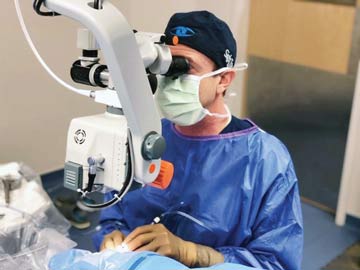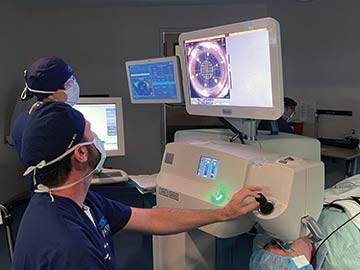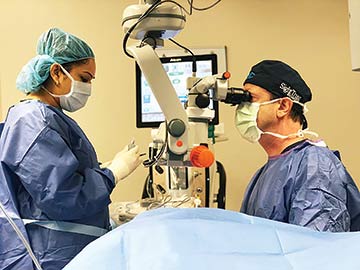Success in cataract surgery is often defined by excellent outcomes achieved quickly and safely. SightTrust Eye Institute in Sunrise, Fla., has that process down to an exact science. Patients arrive, have cataracts removed and new lenses implanted in both eyes and are ready to head home within two hours. The facility's clinical team thrives in this high-volume specialty by relying on coordinated efforts, clear communication and an unwavering committment to patient-centered care.
- Home
- The Magazine
- Article
How to Run an Efficient Eye Center
By: Kendal Gapinski
Published: 3/9/2021
It takes plenty of planning to maintain a brisk pace during days packed with cataract cases.
Getting a head start
Cases should be primed for speed long before patients arrive, according to Andrew C. Shatz, MD, SightTrust's owner and surgeon. "Begin prepping the process during initial surgical evaluations, which can take place days or weeks before scheduled procedures," he says. "We often spend an hour or more with patients during their evaluations, discussing what the procedure will entail and what they should expect to happen." During the evaluations, make sure surgical consents, pre-op paperwork and out-of-pocket payment are completed and collected.
When scheduling procedures, set arrival times at 30- to 40-minute intervals, suggests Victoria Wiltshire, MBA, RN, SightTrust's vice president and chief operating officer. Additionally, review the medical histories of patients and slot those who will require medical clearances before surgery toward the start of the schedule to avoid issues that could cause delays and logjams later in the day, suggests Ms. Wiltshire.
Flagging patients who might present challenging cases, such as those with dense cataracts or poor dilation, lets you allot additional time for these procedures on the schedule. You should also note whether patients will require additional medications, such as epinephrine or Shugarcaine to maintain mydriasis, and make sure the OR staff has these agents premixed and ready to go.
Also highlight patients who will receive toric IOLs and those who need to have their eyes marked before surgery — to treat an astigmatism, for example. "Pull special instrumentation or markers in advance of these cases," says Ms. Wiltshire. "This detailed communication and planning ahead keeps things running on time."

Specializing in bilateral cataracts has helped SightTrust Eye Institute in Sunrise, Fla., run an efficient service line while increasing patient satisfaction. The bilateral option is offered to every patient and most choose to have both eyes treated during a single session, according to Andrew C. Shatz, MD, SightTrust's owner and surgeon.
He began performing bilateral cases after reviewing several large studies that found no difference in complication rates — including infection, retinal detachment and improper IOL implantation — between same-day bilateral cataract surgery and procedures performed on each eye on separate days.
"It's a much more efficient, less stressful process for the patient," says Dr. Shatz. "They don't have to endure two trips to the facility, two sessions of anesthesia, two healing periods and two separate post-op eyedrop regimens. Patients like the idea of one surgery, one healing time."
Treating both eyes during a single case has reduced the number of patient visits during the pandemic, thereby minimizing exposure risks to COVID-19 for everyone in the facility.
Dr. Shatz says patients end up spending an extra 10 minutes in the facility when getting both eyes operated on in the same day and tend to adapt to their new vision more quickly, especially when they opt for multifocal lens implants.
In the flow
Patients must move along a well-orchestrated pathway from pre-op to the PACU. When patients arrive at SightTrust, they're given a pocket lanyard and badge that displays their name, the eye or eyes being operated on, referring doctor, allergies and additional pertinent information in bold letters to make it easy for staff to reference. A surgical technician then brings the patient to pre-op and makes sure required paperwork is on hand before an anesthesiologist applies dilating eye drops.
"An important aspect of cataract surgery is to set the appropriate expectations for patients."
— Andrew C. Shatz, MD
Cataract procedures performed at SightTrust are a two-step process. Patients first enter a procedure room housing a femtosecond laser, which is used to perform a laser-assisted capsulotomy. They're then moved to a sterile operating room outfitted with a phaco machine and surgical microscope. Cataract-affected lenses are emulsified and aspirated from the eye, and new IOLs are implanted. Part of what makes this movement seamless is the use of a stretcher chair, which patients ride from pre-op to recovery. "They never have to leave the surface throughout the entire journey," says Ms. Wiltshire.
The chairs are also programmed to change the patient's position during each stage of the process, which helps boost efficiency and ease of use for staff. The first setting is selected in pre-op, reclining the patient between 30° and 45° (Semi-Fowler's) for administration of pre-op drops. When patients are transported to the laser suite, setting number two is selected, which puts them in a recumbent position at a height that places their eye just below the laser interface. Setting three is used in the operating room to place the patient at a slightly higher recumbent position under the surgical microscope. At the end of the case, setting four is chosen to return patients to a near-upright position while they're moved to the PACU.

"The staff knows exactly what preprogrammed setting to use as soon as the patient gets to the next step of care," says Ms. Wiltshire. "They can also tap a 'home' button at the time of discharge to return the patient to a seated position."
Staff training is also an important part of running an efficient eye center and makes a big difference in moving patients along the perioperative pathway as quickly as possible. At SightTrust, while the patient is being moved from the laser room to the OR by a laser technician and anesthetist, the circulating nurse and scrub tech are waiting in the operating room, ready to immediately start prepping and draping the patient's eye. As that's happening, Dr. Shatz finishes scrubbing in. The patient is typically ready to be operated on as soon as he sits down at the microscope.
Ophthalmic technicians at the facility are cross-trained to run the laser and assist during surgery as scrub technicians. "We have multiple staff members who can handle the same tasks," says Ms. Wiltshire. "Staffing issues are minimized because of this type of versatile coverage."
Anesthesia methods used during surgery should also focus on patient comfort and overall surgical efficiencies, according to Dr. Shatz. He administers topical drops rather than local anesthetic injections around or behind the eye.
"I've always felt that the risk of peribulbar or retrobulbar anesthesia is too high compared with drops," he says. "When using anesthetic drops, you don't have to be concerned about post-injection intraocular pressure elevation. Plus, patients are able to move and blink their eye sooner after surgery, a factor that speeds healing and allows the edema to subside. This increases the overall efficiency of the procedure, decreases the time patients spend in the PACU and speeds visual recovery."

After surgery is complete, make sure patients have quick and easy transitions to home. In recovery, debrief patients and their family members about the procedure, review post-op instructions and schedule follow-up appointments.
As soon as patients are wheeled out of the OR, staff should begin turning over the room and preparing instruments for reprocessing. SightTrust has three full instrument trays, so Dr. Shatz is never kept waiting for sterilized tools to arrive in the OR. Additionally, Ms. Wiltshire notes that all of the trays are set up exactly the same way, which makes preparing sets for surgery and sterilization that much easier.
Comfort with the familiar
Operating efficiently is important, but you must do so without losing focus on what matters most. Dr. Shatz says SightTrust's staff members are trained to talk with patients about the current step in their care and also what's going to happen next. This makes a huge difference in their overall comfort level with the entirety of their care. "An important aspect of cataract surgery is to set the appropriate expectations for patients," says Dr. Shatz. "They'll fear the process if they don't understand it or know what to expect. When they're educated about all of the steps involved, they're better prepared for the experience. And when each step occurs as they expect, they'll know their surgery is going exactly as planned." OSM
.svg?sfvrsn=be606e78_3)
.svg?sfvrsn=56b2f850_5)